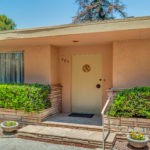Popular Historic Pasadena Neighborhoods
Once the center of the American Arts and Crafts Movement, Pasadena, California, is famous for its wide array of architectural styles employed by premier architects. Even if you aren’t a history or architecture buff, you will surely appreciate Pasadena’s numerous historic neighborhoods. Prime architectural examples include Greene and Greene’s Gamble House and Frederick Roehrig’s Castle Green. Because of its beautiful character homes and historic neighborhoods, Pasadena real estate is highly sought after. Most importantly, the city is extremely walkable and boasts museums, fine restaurants, hiking trails, and an enviable rapid transit system. Pasadena is known for the variety of its neighborhoods; some of the most popular include:
Bungalow Heaven
Pasadena’s first historic district is named Bungalow Heaven because of the hundreds of small Craftsman and Bungalows built in the 1900s-1930s, most of which still remain. This neighborhood experienced a significant restoration in the late 1970s, and many homes have been renovated while remaining true to their historical style. Bungalow Heaven has been designated as one of the “10 Great Places in America” by the American Planning Association.
Chapman Woods
Not quite 500 homes, this neighborhood was once a favorite campsite of California Indians. In later years, large ranchos were established, and in 1869, Alfred B. Chapman acquired nearly 2,000 acres of the Santa Anita Rancho for $10.00 per acre. Subsequently, in the 1920s, Jim Stewart and Ben Quigley opened a real estate office and initiated the subdivision of Chapman Woods into the homes we have today.

Daisy Villa
This is a tree-lined neighborhood of more modest homes. Highlights of Daisy Villa include the popular Victory Park and its Farmer’s Market.
East Orange Grove
Originally referred to as Illinois Street, this modest neighborhood is predominantly residential. East Orange Grove is home to Vina Vieja, an off-leash dog park.
Garfield Heights
Annexed in 1904, Garfield Heights is the second official Historic Landmark District in Pasadena and is one of the city’s oldest intact neighborhoods. Builders mainly constructed beautiful historic homes from the late 1800s to the early 1900s. Architectural styles range from Craftsman, and Bungalows, to small vintage apartment buildings. The neighborhood is architecturally diverse, with over 400 homes, some constructed by notable builders. Garfield Heights experienced a major revitalization in the late 1990s.
Hastings Ranch
Lower Hastings Ranch: In the late 1940s, Edward H. Hired to design the Hasting Ranch tracts, Fickett developed them with predominantly single-family homes. Builders completed the construction of Upper Hastings Ranch in phases, reaching a total of 800 homes in this area by 1951.
Historic Highlands
In 1925, the City of Pasadena incorporated Historic Highlands, transforming it from a remote country outpost into a vibrant neighborhood. Today, nearly 1,000 renovated and restored homes grace the area, showcasing predominantly Craftsman and Bungalow architectural styles.
Jefferson Park
Primarily consisting of modest character homes, the Jefferson Park neighborhood is both easily walkable and bikeable. Spanning nearly 4 ½ acres, the Jefferson Park Recreation Center features volleyball courts, a basketball court, a baseball diamond, and soccer and football overlays.
Linda Vista and Annandale
In the mid-1940s to the early 1950s, Pasadena addressed its housing shortage by constructing new tracts of homes in the Linda Vista area. Now one of Pasadena’s most sought-after locations, this quiet, wooded residential community comprises approximately 1,400 homes across about 2 ½ miles. Linda Vista boasts a variety of beautifully designed mid-century homes, including the highly sought-after mid-century housing tract Pegfair Estates.
Due to its proximity to the Rose Bowl and Old Town, Linda Vista has become a highly sought-after neighborhood. A short distance from Annandale’s business district, San Rafael Park sits adjacent to Colorado Boulevard and Avenue 64. The presence of mature trees further enhances the ambiance of Annandale.
Madison Heights
In the 1910s, the majority of this neighborhood’s development took place, followed by additional growth in the next decade as working professionals moved into the area. Today, people value Madison Heights for its beautiful residences and luxury estates. Ideally positioned between the South Lake Shopping District and Old Town, the neighborhood offers a variety of nearby restaurants and shops.
Oak Knoll
Residents constructed Pasadena’s grandest neighborhood to showcase the native oaks growing in the area before the turn of the 20th century. Oak Knoll’s most notable estate is the former Ritz Carlton, now Langham Huntington Hotel and Spa. Famous architects such as Greene & Greene, Myron Hunt, Sylvanus Marston, and Wallace Neff have designed the beautiful homes and estates in this neighborhood.
Orange Heights
The National Register of Historic Places added Orange Heights to its listings in 1995, marking it as the first Pasadena neighborhood to receive this distinction. Previously recognized as “Pill Hill” due to its significant population of physicians and caregivers, Orange Heights has consistently held a central role in Pasadena’s civic life. Even today, the neighborhood retains much of its appearance from a century ago.

San Rafael
By the 1940s, Pasadena’s housing shortage led to the development of the San Rafael neighborhood, with new homes constructed for wealthier residents. Predominantly residential, this neighborhood may feel isolated, but it’s still near shopping and restaurants. This sought-after community offers a variety of secluded, hillside properties, including some dramatic mid-century homes. Many homes enjoy the sweeping city, mountain, or arroyo views.
Washington Square
This historic district encompasses approximately 250 homes slowly built between 1910 and 1940. Over the years, this area has undergone multiple name changes. Originally, it was known as a portion of Orange Heights, then Clement Heights, later shortened to CLEM, and subsequently renamed Heather Heights. Finally, in the late 1990s, it underwent another change and was officially renamed Washington Square. Architectural styles range from Craftsman, Tudor, English Cottage, and Spanish to Traditional.
Are you dreaming of making Pasadena your home? Contact us for a 15-minute buyer consultation. It’s simple and free, and there is no commitment.




